Portal:Computer programming
Portal maintenance status: (September 2019)
|
The Computer Programming Portal
Computer programming or coding is the composition of sequences of instructions, called programs, that computers can follow to perform tasks. It involves designing and implementing algorithms, step-by-step specifications of procedures, by writing code in one or more programming languages. Programmers typically use high-level programming languages that are more easily intelligible to humans than machine code, which is directly executed by the central processing unit. Proficient programming usually requires expertise in several different subjects, including knowledge of the application ___domain, details of programming languages and generic code libraries, specialized algorithms, and formal logic.
Auxiliary tasks accompanying and related to programming include analyzing requirements, testing, debugging (investigating and fixing problems), implementation of build systems, and management of derived artifacts, such as programs' machine code. While these are sometimes considered programming, often the term software development is used for this larger overall process – with the terms programming, implementation, and coding reserved for the writing and editing of code per se. Sometimes software development is known as software engineering, especially when it employs formal methods or follows an engineering design process. (Full article...)
Selected articles - load new batch
-
Image 1

PDP-11 CPU board
Computer hardware includes the physical parts of a computer, such as the central processing unit (CPU), random-access memory (RAM), motherboard, computer data storage, graphics card, sound card, and computer case. It includes external devices such as a monitor, mouse, keyboard, and speakers.
By contrast, software is a set of written instructions that can be stored and run by hardware. Hardware derived its name from the fact it is hard or rigid with respect to changes, whereas software is soft because it is easy to change.
Hardware is typically directed by the software to execute any command or instruction. A combination of hardware and software forms a usable computing system, although other systems exist with only hardware. (Full article...) -
Image 2

The Greek lowercase omega (ω) character is used to represent Null in database theory.
In SQL, null or NULL is a special marker used to indicate that a data value does not exist in the database. Introduced by the creator of the relational database model, E. F. Codd, SQL null serves to fulfill the requirement that all true relational database management systems (RDBMS) support a representation of "missing information and inapplicable information". Codd also introduced the use of the lowercase Greek omega (ω) symbol to represent null in database theory. In SQL,NULLis a reserved word used to identify this marker.
A null should not be confused with a value of 0. A null indicates a lack of a value, which is not the same as a zero value. For example, consider the question "How many books does Adam own?" The answer may be "zero" (we know that he owns none) or "null" (we do not know how many he owns). In a database table, the column reporting this answer would start with no value (marked by null), and it would not be updated with the value zero until it is ascertained that Adam owns no books.
In SQL, null is a marker, not a value. This usage is quite different from most programming languages, where a null value of a reference means it is not pointing to any object. (Full article...) -
Image 3Java is a high-level, general-purpose, memory-safe, object-oriented programming language. It is intended to let programmers write once, run anywhere (WORA), meaning that compiled Java code can run on all platforms that support Java without the need to recompile. Java applications are typically compiled to bytecode that can run on any Java virtual machine (JVM) regardless of the underlying computer architecture. The syntax of Java is similar to C and C++, but has fewer low-level facilities than either of them. The Java runtime provides dynamic capabilities (such as reflection and runtime code modification) that are typically not available in traditional compiled languages.
Java gained popularity shortly after its release, and has been a popular programming language since then. Java was the third most popular programming language in 2022[update] according to GitHub. Although still widely popular, there has been a gradual decline in use of Java in recent years with other languages using JVM gaining popularity.
Java was designed by James Gosling at Sun Microsystems. It was released in May 1995 as a core component of Sun's Java platform. The original and reference implementation Java compilers, virtual machines, and class libraries were released by Sun under proprietary licenses. As of May 2007, in compliance with the specifications of the Java Community Process, Sun had relicensed most of its Java technologies under the GPL-2.0-only license. Oracle, which bought Sun in 2010, offers its own HotSpot Java Virtual Machine. However, the official reference implementation is the OpenJDK JVM, which is open-source software used by most developers and is the default JVM for almost all Linux distributions. (Full article...) -
Image 4
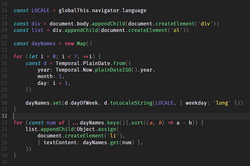
Source code for a computer program written in the JavaScript language. It demonstrates the appendChild method. The method adds a new child node to an existing parent node. It is commonly used to dynamically modify the structure of an HTML document.
A computer program is a sequence or set of instructions in a programming language for a computer to execute. It is one component of software, which also includes documentation and other intangible components.
A computer program in its human-readable form is called source code. Source code needs another computer program to execute because computers can only execute their native machine instructions. Therefore, source code may be translated to machine instructions using a compiler written for the language. (Assembly language programs are translated using an assembler.) The resulting file is called an executable. Alternatively, source code may execute within an interpreter written for the language.
If the executable is requested for execution, then the operating system loads it into memory and starts a process. The central processing unit will soon switch to this process so it can fetch, decode, and then execute each machine instruction. (Full article...) -
Image 5
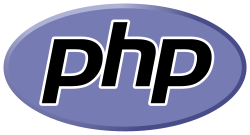
PHP is a general-purpose scripting language geared towards web development. It was originally created by Danish-Canadian programmer Rasmus Lerdorf in 1993 and released in 1995. The PHP reference implementation is now produced by the PHP Group. PHP was originally an abbreviation of Personal Home Page, but it now stands for the recursive backronym PHP: Hypertext Preprocessor.
PHP code is usually processed on a web server by a PHP interpreter implemented as a module, a daemon or a Common Gateway Interface (CGI) executable. On a web server, the result of the interpreted and executed PHP code—which may be any type of data, such as generated HTML or binary image data—would form the whole or part of an HTTP response. Various web template systems, web content management systems, and web frameworks exist that can be employed to orchestrate or facilitate the generation of that response. Additionally, PHP can be used for many programming tasks outside the web context, such as standalone graphical applications and drone control. PHP code can also be directly executed from the command line.
The standard PHP interpreter, powered by the Zend Engine, is free software released under the PHP License. PHP has been widely ported and can be deployed on most web servers on a variety of operating systems and platforms. (Full article...) -
Image 6

Tcl (pronounced "tickle" or "TCL"; originally Tool Command Language) is a high-level, general-purpose, interpreted, dynamic programming language. It was designed with the goal of being very simple but powerful. Tcl casts everything into the mold of a command, even programming constructs like variable assignment and procedure definition. Tcl supports multiple programming paradigms, including object-oriented, imperative, functional, and procedural styles.
It is commonly used embedded into C applications, for rapid prototyping, scripted applications, GUIs, and testing. Tcl interpreters are available for many operating systems, allowing Tcl code to run on a wide variety of systems. Because Tcl is a very compact language, it is used on embedded systems platforms, both in its full form and in several other small-footprint versions.
The popular combination of Tcl with the Tk extension is referred to as Tcl/Tk (pronounced "tickle teak"[citation needed] or "tickle TK") and enables building a graphical user interface (GUI) natively in Tcl. Tcl/Tk is included in the standard Python installation in the form of Tkinter. (Full article...) -
Image 7
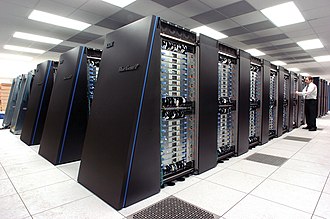
Large supercomputers such as IBM's Blue Gene/P are designed to heavily exploit parallelism.
Parallel computing is a type of computation in which many calculations or processes are carried out simultaneously. Large problems can often be divided into smaller ones, which can then be solved at the same time. There are several different forms of parallel computing: bit-level, instruction-level, data, and task parallelism. Parallelism has long been employed in high-performance computing, but has gained broader interest due to the physical constraints preventing frequency scaling. As power consumption (and consequently heat generation) by computers has become a concern in recent years, parallel computing has become the dominant paradigm in computer architecture, mainly in the form of multi-core processors.
In computer science, parallelism and concurrency are two different things: a parallel program uses multiple CPU cores, each core performing a task independently. On the other hand, concurrency enables a program to deal with multiple tasks even on a single CPU core; the core switches between tasks (i.e. threads) without necessarily completing each one. A program can have both, neither or a combination of parallelism and concurrency characteristics.
Parallel computers can be roughly classified according to the level at which the hardware supports parallelism, with multi-core and multi-processor computers having multiple processing elements within a single machine, while clusters, MPPs, and grids use multiple computers to work on the same task. Specialized parallel computer architectures are sometimes used alongside traditional processors, for accelerating specific tasks. (Full article...) -
Image 8COBOL (/ˈkoʊbɒl, -bɔːl/; an acronym for "common business-oriented language") is a compiled English-like computer programming language designed for business use. It is an imperative, procedural, and, since 2002, object-oriented language. COBOL is primarily used in business, finance, and administrative systems for companies and governments. COBOL is still widely used in applications deployed on mainframe computers, such as large-scale batch and transaction processing jobs. Many large financial institutions were developing new systems in the language as late as 2006, but most programming in COBOL today is purely to maintain existing applications. Programs are being moved to new platforms, rewritten in modern languages, or replaced with other software.
COBOL was designed in 1959 by CODASYL and was partly based on the programming language FLOW-MATIC, designed by Grace Hopper. It was created as part of a U.S. Department of Defense effort to create a portable programming language for data processing. It was originally seen as a stopgap, but the Defense Department promptly pressured computer manufacturers to provide it, resulting in its widespread adoption. It was standardized in 1968 and has been revised five times. Expansions include support for structured and object-oriented programming. The current standard is ISO/IEC 1989:2023.
COBOL statements have prose syntax such asMOVE x TO y, which was designed to be self-documenting and highly readable. However, it is verbose and uses over 300 reserved words compared to the succinct and mathematically inspired syntax of other languages. (Full article...) -
Image 9
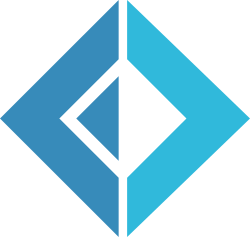
F# (pronounced F sharp) is a general-purpose, high-level, strongly typed, multi-paradigm programming language that encompasses functional, imperative, and object-oriented programming methods. It is most often used as a cross-platform Common Language Infrastructure (CLI) language on .NET, but can also generate JavaScript and graphics processing unit (GPU) code.
F# is developed by the F# Software Foundation, Microsoft and open contributors. An open source, cross-platform compiler for F# is available from the F# Software Foundation. F# is a fully supported language in Visual Studio and JetBrains Rider. Plug-ins supporting F# exist for many widely used editors including Visual Studio Code, Vim, and Emacs.
F# is a member of the ML language family and originated as a .NET Framework implementation of a core of the programming language OCaml. It has also been influenced by C#,
Python, Haskell, Scala and Erlang. (Full article...) -
Image 10Artificial intelligence (AI) is the capability of computational systems to perform tasks typically associated with human intelligence, such as learning, reasoning, problem-solving, perception, and decision-making. It is a field of research in computer science that develops and studies methods and software that enable machines to perceive their environment and use learning and intelligence to take actions that maximize their chances of achieving defined goals.
High-profile applications of AI include advanced web search engines (e.g., Google Search); recommendation systems (used by YouTube, Amazon, and Netflix); virtual assistants (e.g., Google Assistant, Siri, and Alexa); autonomous vehicles (e.g., Waymo); generative and creative tools (e.g., language models and AI art); and superhuman play and analysis in strategy games (e.g., chess and Go). However, many AI applications are not perceived as AI: "A lot of cutting edge AI has filtered into general applications, often without being called AI because once something becomes useful enough and common enough it's not labeled AI anymore."
Various subfields of AI research are centered around particular goals and the use of particular tools. The traditional goals of AI research include learning, reasoning, knowledge representation, planning, natural language processing, perception, and support for robotics. To reach these goals, AI researchers have adapted and integrated a wide range of techniques, including search and mathematical optimization, formal logic, artificial neural networks, and methods based on statistics, operations research, and economics. AI also draws upon psychology, linguistics, philosophy, neuroscience, and other fields. Some companies, such as OpenAI, Google DeepMind and Meta, aim to create artificial general intelligence (AGI)—AI that can complete virtually any cognitive task at least as well as a human. (Full article...) -
Image 11

Computer class at Chkalovski Village School No. 2 in 1985–1986
The history of computing in the Soviet Union began in the late 1940s, when the country began to develop its Small Electronic Calculating Machine (MESM) at the Kiev Institute of Electrotechnology in Feofaniya. Initial ideological opposition to cybernetics in the Soviet Union was overcome by a Khrushchev era policy that encouraged computer production.
By the early 1970s, the uncoordinated work of competing government ministries had left the Soviet computer industry in disarray. Due to lack of common standards for peripherals and lack of digital storage capacity the Soviet Union's technology significantly lagged behind the West's semiconductor industry. The Soviet government decided to abandon development of original computer designs and encouraged cloning of existing Western systems (e.g. the 1801 CPU series was scrapped in favor of the PDP-11 ISA by the early 1980s).
Soviet industry was unable to mass-produce computers to acceptable quality standards and locally manufactured copies of Western hardware were unreliable. As personal computers spread to industries and offices in the West, the Soviet Union's technological lag increased. (Full article...) -
Image 12
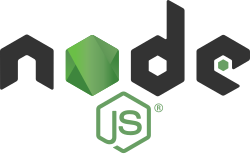
Node.js is a cross-platform, open-source JavaScript runtime environment that can run on Windows, Linux, Unix, macOS, and more. Node.js runs on the V8 JavaScript engine, and executes JavaScript code outside a web browser.
Node.js lets developers use JavaScript to write command line tools and server-side scripting. The ability to run JavaScript code on the server is often used to generate dynamic web page content before the page is sent to the user's web browser. Consequently, Node.js represents a "JavaScript everywhere" paradigm, unifying web-application development around a single programming language, as opposed to using different languages for the server- versus client-side programming.
Node.js has an event-driven architecture capable of asynchronous I/O. These design choices aim to optimize throughput and scalability in web applications with many input/output operations, as well as for real-time Web applications (e.g., real-time communication programs and browser games). (Full article...) -
Image 13In C++ computer programming, allocators are a component of the C++ Standard Library. The standard library provides several data structures, such as list and set, commonly referred to as containers. A common trait among these containers is their ability to change size during the execution of the program. To achieve this, some form of dynamic memory allocation is usually required. Allocators handle all the requests for allocation and deallocation of memory for a given container. The C++ Standard Library provides general-purpose allocators that are used by default; however, custom allocators may also be supplied by the programmer.
Allocators were invented by Alexander Stepanov as part of the Standard Template Library (STL). They were originally intended as a means to make the library more flexible and independent of the underlying memory model, allowing programmers to utilize custom pointer and reference types with the library. However, in the process of adopting STL into the C++ standard, the C++ standardization committee realized that a complete abstraction of the memory model would incur unacceptable performance penalties. To remedy this, the requirements of allocators were made more restrictive. As a result, the level of customization provided by allocators is more limited than was originally envisioned by Stepanov.
Nevertheless, there are many scenarios where customized allocators are desirable. Some of the most common reasons for writing custom allocators include improving performance of allocations by using memory pools, and encapsulating access to different types of memory, like shared memory or garbage-collected memory. In particular, programs with many frequent allocations of small amounts of memory may benefit greatly from specialized allocators, both in terms of running time and memory footprint. (Full article...) -
Image 14

A computer lab contains a wide range of information technology elements,
including hardware, software and storage systems.
Information technology (IT) is the study or use of computers, telecommunication systems and other devices to create, process, store, retrieve and transmit information. While the term is commonly used to refer to computers and computer networks, it also encompasses other information distribution technologies such as television and telephones. Information technology is an application of computer science and computer engineering.
An information technology system (IT system) is generally an information system, a communications system, or, more specifically speaking, a computer system — including all hardware, software, and peripheral equipment — operated by a limited group of IT users, and an IT project usually refers to the commissioning and implementation of an IT system. IT systems play a vital role in facilitating efficient data management, enhancing communication networks, and supporting organizational processes across various industries. Successful IT projects require meticulous planning and ongoing maintenance to ensure optimal functionality and alignment with organizational objectives.
Although humans have been storing, retrieving, manipulating, analysing and communicating information since the earliest writing systems were developed, the term information technology in its modern sense first appeared in a 1958 article published in the Harvard Business Review; authors Harold J. Leavitt and Thomas L. Whisler commented that "the new technology does not yet have a single established name. We shall call it information technology (IT)." Their definition consists of three categories: techniques for processing, the application of statistical and mathematical methods to decision-making, and the simulation of higher-order thinking through computer programs. (Full article...) -
Image 15
JavaScript (JS) is a programming language and core technology of the web platform, alongside HTML and CSS. Ninety-nine percent of websites on the World Wide Web use JavaScript on the client side for webpage behavior.
Web browsers have a dedicated JavaScript engine that executes the client code. These engines are also utilized in some servers and a variety of apps. The most popular runtime system for non-browser usage is Node.js.
JavaScript is a high-level, often just-in-time–compiled language that conforms to the ECMAScript standard. It has dynamic typing, prototype-based object-orientation, and first-class functions. It is multi-paradigm, supporting event-driven, functional, and imperative programming styles. It has application programming interfaces (APIs) for working with text, dates, regular expressions, standard data structures, and the Document Object Model (DOM). (Full article...)
Selected images
-
Image 2This image (when viewed in full size, 1000 pixels wide) contains 1 million pixels, each of a different color.
-
Image 3Partial view of the Mandelbrot set. Step 1 of a zoom sequence: Gap between the "head" and the "body" also called the "seahorse valley".
-
Image 4Margaret Hamilton standing next to the navigation software that she and her MIT team produced for the Apollo Project.
-
Image 5Deep Blue was a chess-playing expert system run on a unique purpose-built IBM supercomputer. It was the first computer to win a game, and the first to win a match, against a reigning world champion under regular time controls. Photo taken at the Computer History Museum.
-
Image 7Partial map of the Internet based on the January 15, 2005 data found on opte.org. Each line is drawn between two nodes, representing two IP addresses. The length of the lines are indicative of the delay between those two nodes. This graph represents less than 30% of the Class C networks reachable by the data collection program in early 2005.
-
Image 8A view of the GNU nano Text editor version 6.0
-
Image 9Ada Lovelace was an English mathematician and writer, chiefly known for her work on Charles Babbage's proposed mechanical general-purpose computer, the Analytical Engine. She was the first to recognize that the machine had applications beyond pure calculation, and to have published the first algorithm intended to be carried out by such a machine. As a result, she is often regarded as the first computer programmer.
-
Image 10Grace Hopper at the UNIVAC keyboard, c. 1960. Grace Brewster Murray: American mathematician and rear admiral in the U.S. Navy who was a pioneer in developing computer technology, helping to devise UNIVAC I. the first commercial electronic computer, and naval applications for COBOL (common-business-oriented language).
-
Image 11A head crash on a modern hard disk drive
-
Image 13GNOME Shell, GNOME Clocks, Evince, gThumb and GNOME Files at version 3.30, in a dark theme
-
Image 14Stephen Wolfram is a British-American computer scientist, physicist, and businessman. He is known for his work in computer science, mathematics, and in theoretical physics.
-
Image 15Output from a (linearised) shallow water equation model of water in a bathtub. The water experiences 5 splashes which generate surface gravity waves that propagate away from the splash locations and reflect off of the bathtub walls.
-
Image 16A lone house. An image made using Blender 3D.
-
Image 17An IBM Port-A-Punch punched card
Did you know? - load more entries

- ... that NATO was once targeted by a group of "gay furry hackers"?
- ... that the programming language Acorn System BASIC was so non-standard that one commenter suggested that using it on the BBC Micro would be a disaster?
- ... that Cornell University's student-oriented programming language dialect was made available to other universities but required a "research grant" payment in exchange?
- ... that Phil Fletcher as Hacker T. Dog caused Lauren Layfield to make the "most famous snort" in the United Kingdom in 2016?
- ... that a pink skin for Mercy in the video game Overwatch helped raise more than $12 million for breast cancer research?
- ... that both Thackeray and Longfellow bought paintings by Fanny Steers?
Subcategories
WikiProjects
- There are many users interested in computer programming, join them.
Computer programming news
No recent news
Topics
Related portals
Associated Wikimedia
The following Wikimedia Foundation sister projects provide more on this subject:
-
Commons
Free media repository -
Wikibooks
Free textbooks and manuals -
Wikidata
Free knowledge base -
Wikinews
Free-content news -
Wikiquote
Collection of quotations -
Wikisource
Free-content library -
Wikiversity
Free learning tools -
Wiktionary
Dictionary and thesaurus









































